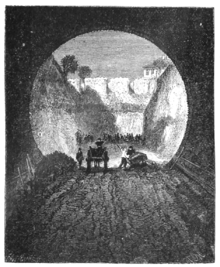Union Tunnel (Baltimore)
This article needs additional citations for verification. (May 2013) |
The Union Tunnel is a pair of railroad tunnels on Amtrak's Northeast Corridor in Baltimore, Maryland that connect Pennsylvania Station to the Pennsylvania Railroad's original mainline to Philadelphia, Pennsylvania and points north. The original tunnel was built in 1873, while a second one was completed in 1934.
Original tunnel[]

The Union Tunnel was originally constructed as part of the Union Railroad and served as the northern and eastern approach to Baltimore Union Station (now called Pennsylvania Station). In all, the Union Railroad was 9.62 miles (15.48 km) in length, extending from the northern terminus of the Baltimore and Potomac Rail Road to the southern terminus of the Northern Central Railway.[1] The junction with the Baltimore and Potomac lies between Pennsylvania Station and the northern portal of the Baltimore and Potomac Tunnel. The Union Railroad joined the Northern Central at Bayview Junction, Maryland 39°17′48″N 76°33′12″W / 39.29677°N 76.5533°W on the northeast side of Baltimore.
In 1866 the Canton Company of Baltimore obtained a charter from State of Maryland to build the Union Railroad.[1] Active steps to finance construction of the railroad and tunnel came only in the autumn of 1870, and actual construction began on May 1, 1871. On July 24, 1873, the first train passed through the tunnel.[2][3] The original tunnel began at Bond Street, and passed under the bed of Hoffman Street to Greenmount Avenue, crossing under Dallas, Caroline, Spring and Eden Streets, Central and Harford Avenues, and Ensor, Valley and McKim Streets. Its length is 3,410 feet (1,040 m). The total cost of the road and tunnel was some $3,000,000.[3]
As soon as the Union Railroad was completed, the Northern Central Railway obtained the right to use it, and in February, 1882, the Northern Central purchased the Union Railroad stock from the Canton Company, and assumed control March 1 of the same year.[3]
Modifications[]
Additional work was done on the tunnels between 1928 and 1935 to prepare for the electrification of the Pennsylvania Railroad's New York-Washington mainline. The original Union Tunnel, too small to accommodate overhead catenary on its two tracks, was supplemented by an adjacent double-track tunnel to the east, then converted to a single track which provided adequate clearance for electrification. Coordinates: 39°18′21″N 76°36′32″W / 39.3058°N 76.6088°W
References[]
- ^ a b Wilson, William Bender (1899). History of the Pennsylvania Railroad Company. Vol. 1. Philadelphia: Henry T. Coates & Co. p. 277.
- ^ Churella, Albert J. (2012). The Pennsylvania Railroad. Vol. 1. Philadelphia: University of Pennsylvania Press. p. 358. ISBN 9780812207620.
- ^ a b c Hall, Clayton C., ed. (1912). Baltimore: Its History and Its People. Vol. 1. New York: Lewis Historical Pub. Co. p. 488.
- Amtrak tunnels
- Pennsylvania Railroad tunnels
- Railroad tunnels in Maryland
- Transportation buildings and structures in Baltimore
- Tunnels completed in 1873
- 1873 establishments in Maryland
- United States rail transportation stubs
- American tunnel stubs
 WikiMiniAtlas
WikiMiniAtlas